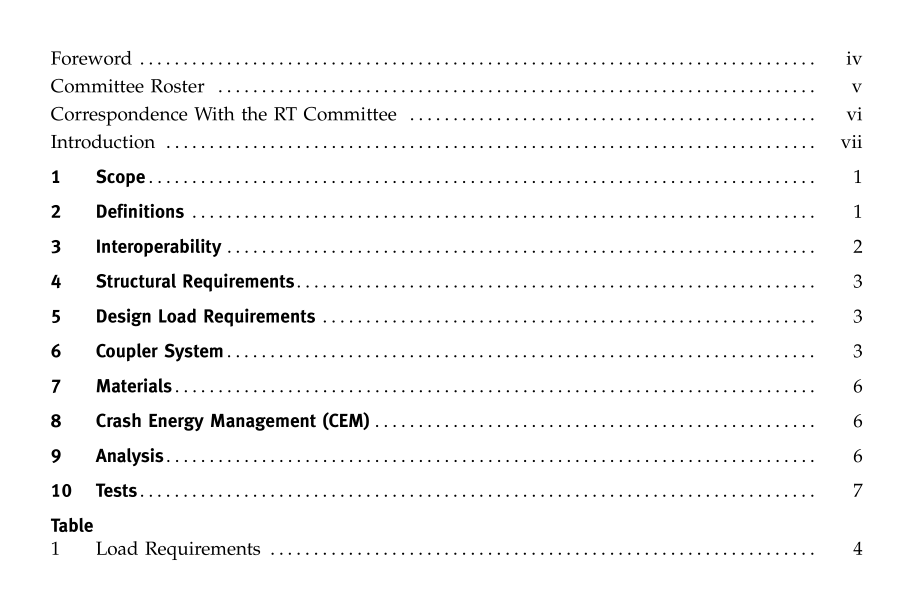ASME RT-2:2008 pdf free download Safety Standard for Structural Requirements for Heavy Rail Transit Vehicles
1 sCOPE
1.1 Subjects Covered by This Standard
This Standard applies to carbodies of newly con-structed heavy rail transit vehicles for transit passengerservice in North America. It defines requirements forthe incorporation of passive safety design conceptsrelated to the performance of the carbody of heavy railtransit vehicles in conditions such as collisions, so as toenhance passenger safety, and limit and control damage.This Standard does not cover light rail vehicles,auto-mated people movers, and freight, commuter, high-speed, or any other rail vehicles under the jurisdictionof the Federal Railroad Administration.
1.2 Subjects Not Addressed by This Standard
There are several issues related to safety not addressed,such as, but not limited to
(a) structural repairs(b) fatigue
(c) corrosion
(d) fire protection(NFPA 130)(e) interior vehicle design
(f) emergency egress from vehicle (NFPA 130)1.3 Effective Date
This Standard applies to carbodies of newly con-structed heavy rail transit vehicles for transit passengerservice in North America ordered 180 days followingthe date of issuance of this Standard by the StandardsCommittee and ASME.
DEFINITIONS
This Standard relies, where practical, on terms alreadyin use by ASME,the American Public TransportationAssociation (APTA), and the Institute of Electrical andElectronics Engineers (IEEE). For the purposes of thisStandard, the following definitions apply:
anticlimber: a structural member located at each end ofthe vehicle, used to engage the anticlimber of an oppos-ing or otherwise coupled vehicle to resist relative verticaltravel between the two carbodies during a collision.antitelescoping plate: a single structural member thatspans the full width of the carbody at the top of the endframe, that is attached to the tops of the collision and corner posts, and is designed to transmit the collisionand corner post top reaction loads to the carbody sides.belf rail: a longitudinal structural member in the sideframe arranged below the passenger side windows.carbody (heaoy rail): the vehicle body consists of the mainload-carrying structure above all truck suspension units.It includes all components that are connected to thisstructure and contribute directly to its strength, stiffness,and stability. Mechanical or electrical equipment andother mounted parts are not considered part of the car-body, though their attachment brackets are.
closing speed: the relative speed of a vehicle to anotherobject or vehicle at the time of initial impact.
collision posts (heay rail fransif): a set of two structuralposts located at each end of the carbody, extending fromthe bottom of the underframe structure up to anantitelescoping plate. They are located at the approxi-mate one-third points across the width of the vehicle,and are forward of the seating position of any passengeror crew person.
consist: the makeup or composition of the individualunits of a train, generally by number and type of vehicle.corner posts(RT-2): a set of two structural posts locatedat the outside corners of the passenger compartment orat the extreme corners of the carbody, extending fromthe bottom of the underframe structure up to anantitelescoping plate and to the roof at the top of theside frame at its intersection with the roof.
crash energy anagement (CEM): a method of design andmanufacture of vehicle structures that assigns certainsections of the carbody the task of absorbing a portionof the energy of collision by crushing in a controlledmanner (see structural energy absorption zone). The con-trolled crushing and energy absorption functions aretypically assigned to specialcarbody structural membersin the structural energy absorption zone that aredesigned to crush in a predictable and stable mannerover a distance that depends on the design of the mem-ber and the desired amount of energy absorption. Theuse of supplementary energy-absorbing element(s) maybe specified.
crasirortriness (RT-2): the ability of a carbody to managethe energy of a collision while maintaining structuralintegrity, so as to minimize injury to occupants.
ASME RT-2:2008 pdf free download
